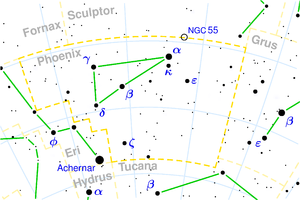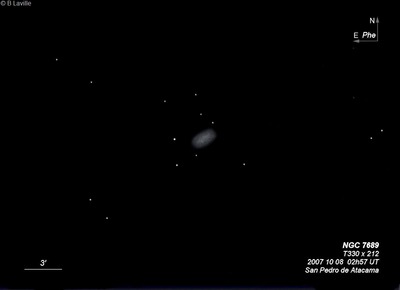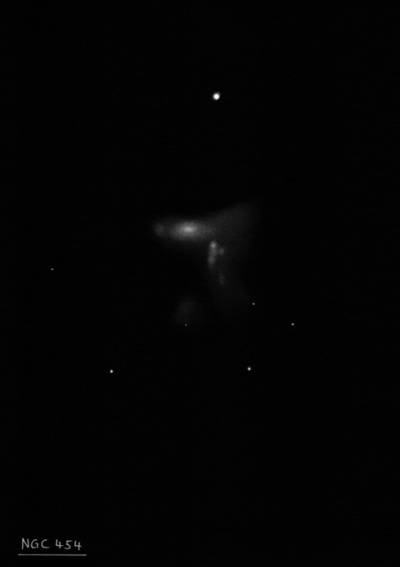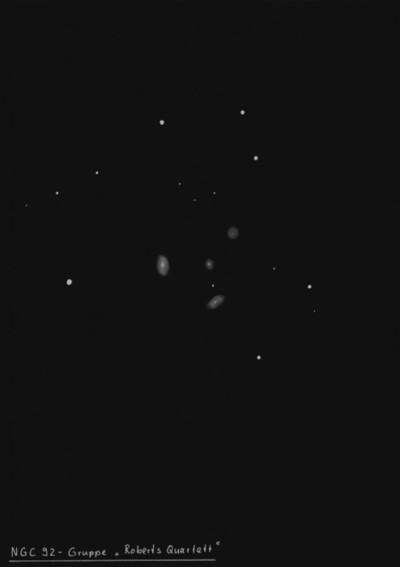A constellation of the southern sky lying outside the Milky Way between Fomalhaut of the Piscis Austrinus and Achernar of Eridanus. Only the northern part of the constellation rises 1 degree above the horizon during the autumn months. Just above the horizon the whole constellation appears only in the southern regions of the Mediterranean. With the exception of the star SX Phoenicia, Phoenix contains essentially no objects of interest. In this part of the sky, however, a view of the world of distant (faint) galaxies is uncovered. The quartet of NGC 87-88-89 and NGC 92, 180 million light-years away, is a tour of different types of star systems in large telescopes: NGC 87 is an irregular galaxy, NGC 88 is a spiral galaxy with an outer gas envelope, NGC 89 has two distinctive broad arms, and NGC 92 has one exceptionally long spiral arm.

Ankaa (α Phe) - The brightest star of the constellation. Its brightness reaches 2.3mag. It is distinctly orange and belongs to the spectral class KO. It is located on the northern edge of the constellation and for observers at 40 degrees north latitude, it culminates at a height of 8 degrees above the southern horizon. It is located at a distance of 77 light years.
β Phe - A close binary star with a separation of 1.4", whose individual components of 4 magnitude and 4.2 mm can be resolved by telescopes with an objective diameter of around 15 cm. The system is located 198 light years away. In the field of view at a distance of 58", we can still see another companion with a brightness of 11.5 magnitude.
ζ Phe - Optical double star, whose components at a separation of 6.4" can be easily resolved even with a small telescope. The fainter one has a magnitude of 8mag. The brighter one changes its brightness every 40 hours, as it is an eclipsing variable star of the Algol type. It changes its brightness from 3.9mag to 4.4mag, which can be easily observed with the naked eye.
η Phe - A binary star, whose components have a brightness difference of 19.8". The brighter one reaches a magnitude of 4.5, while the companion exhibits an 11th magnitude.
ξ Phe - A well-resolvable double star for a telescope with an objective diameter of around 100 mm. The primary component has a brightness of 6 mag, while the companion is at a separation of 13.2" and has a brightness of 10 mag.
SX Phe - Dwarf Cepheid, a variable star whose brightness changes from 7.1mag to 7.5mag every 79 minutes and 10 seconds! However, sometimes it brightens up to 6.7mag.
NGC 7689

James Dunlop possibly discovered NGC 7689 = D 347 = h7689 on 5 Sep 1826 and described a "faint round nebula, about 20" diameter." His position is 17' too far east-southeast. John Herschel found this galaxy on 5 Sep 1826 and noted "pF; L; R; vglbM; 2'." His RA was 40 seconds too small and this error was repeated in the RC2 and RNGC. Listed in my RNGC Corrections #6.
600/800mm - 30" (10/13/15 - OzSky): at 303; bright, very large, oval 3:2 or 5:3 NW-SE, ~2.7'x1.8', contains a relatively large brighter core that is only weakly concentrated. Spiral structure is evident. A short arm is attached on the southeast side of the core and extends east. A second arm appears to be attached on the southwest side of the core and extends southeast. Finally a third arm appears to the north of the core. The halo is patchy or mottled on the northwest side (HII regions or parts of an arm). A mag 11 star is 2.2' E of center, a mag 15 star is at the north-northwest edge of the halo and a mag 16 star (or stellar knot) is at the northeast edge of the halo.
Notes by Steve Gottlieb
NGC 454

John Herschel discovered NGC 454 = h2397 on 5 Oct 1834 and logged "vF, S, R, bM, 15 arcsec." His position is accurate.
600/800mm - 25" (10/15/17 - OzSky): NGC 454 was resolved into a neat contact double system at 244x [28" separation between centers], though better viewed at 397x. The main component is on the east side and appeared moderately bright, fairly small, elongated ~2:1 E-W, ~50"x25". At 397x it was sharply concentrated with an extremely high surface brightness elongated core and stellar nucleus. The interacting companion, PGC 4461, appears as an appendage, poking out of the southwest side and was easily seen at 397x. It appeared faint or fairly faint, small, probably elongated ~3:2 N-S, ~20"x14". On the DSS, this galaxy is highly disrupted with plumes and knots. A mag 11.9 star lies 1.6' NNW. Situated 4.7' WSW of mag 8.3 HD 7597.
Notes by Steve Gottlieb
NGC 92

ESO 194-013, a fifth member of the group, lies 11' ENE. At 429x, it appeared moderately bright, moderately large, elongated 4:3 SW-NE, 0.9'x0.7', broad concentration with a slightly brighter core but no distinct zones. A distinctive string of three mag 13 stars [length 1.4'] is centered 2' E.
John Herschel discovered NGC 92 = h2319 (along with NGC 87, 88 and 89) on 30 Sep 1834 and recorded "F, R, gbM; 20" across. The last of four"."
600/800mm - 30" (11/4/10 - Coonabarabran, 429x): this galaxy is the brightest member and furthest east in the compact Phoenix Quartet (Rose 34). It appeared moderately bright, moderately large, elongated 2:1 NW-SE, 1.2'x0.6', broad concentration to a bright core. A faint tidal tail to the SE was not seen. The nearby members of the quartet are NGC 87 2.9' W, NGC 88 1.9' SW and NGC 89 2.6' SSW.
Notes by Steve Gottlieb